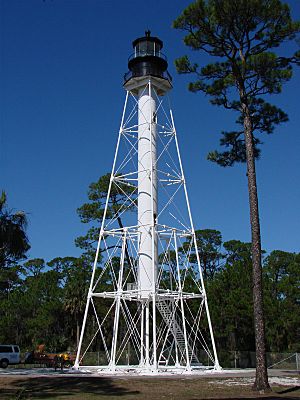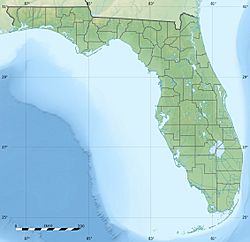Cape San Blas Light facts for kids
 |
|
| Cape San Blas Light in its original location | |
|
|
|
| Location | Cape San Blas southwest of Port St. Joe Florida United States |
|---|---|
| Coordinates | 29°48′48″N 85°18′23″W / 29.813199°N 85.306499°W |
| Year first constructed | 1848 (first) 1859 (second) 1882 (third) |
| Year first lit | 1885 (current) |
| Automated | 1981 |
| Deactivated | 1996 |
| Foundation | iron piling |
| Construction | cast iron skeletal tower |
| Tower shape | square pyramidal skeleton tower with central cylinder, balcony and lantern |
| Markings / pattern | white tower, black lantern |
| Height | 98 feet (30 m) |
| Focal height | 101 feet (31 m) |
| Original lens | Third order Fresnel lens (1859) Third order bivalve Fresnel lens (1906) |
| Range | 14 nautical miles; 26 kilometres (16 mi) |
| Characteristic | Fl W 20s. |
| Admiralty number | J3366 |
| ARLHS number | USA-135 |
The Cape San Blas Light is a famous lighthouse in Florida, United States. It's special because four different lighthouses were built here between 1849 and 1885. This lighthouse was originally located at Cape San Blas in the northwestern part of Florida.
Over many years, the beach around the lighthouse started to wear away due to erosion and strong storms. Because of this, the lighthouse had to be moved in 2014 to Port St. Joe. This historic lighthouse was added to the National Register of Historic Places in 2015, which means it's recognized as an important historical site.
A History of Moving Lighthouses
The Cape San Blas Light has a long and challenging history. It was built in a spot where the land kept changing.
The First Lighthouse (1849)
The first lighthouse at Cape San Blas was finished in 1849. It was built to warn ships about dangerous sandbanks, called shoals, that stretched out about 4 or 5 miles (6.4 to 8.0 km) from the cape. These shoals made it risky for ships sailing near the coast.
Even though the tower was 85 to 90 feet (26 to 27 m) tall, its light could only be seen for about 10 miles (16 km). This was only half the distance needed to guide ships safely. Sadly, this first lighthouse fell down during a strong storm in 1851.
The Second Lighthouse (1856)
After the first one was destroyed, money was approved to build a new lighthouse. This second lighthouse was completed in 1856. But just a few months later, another severe storm hit on August 30, 1856. The storm was so powerful that the sea rose very high. Waves crashed into the keeper's house, which was 8 feet (2.4 m) off the ground. This lighthouse was also completely destroyed. The area where it stood became a lagoon, a shallow body of water.
The Third Lighthouse (1858)
For the third time, Congress approved money for a lighthouse at Cape San Blas. This new lighthouse was finished and first lit on May 1, 1858. It used a special "third-order lens" to make its light brighter.
Damage During the Civil War
During the Civil War, in 1862, soldiers from the Union damaged the lighthouse. The keeper's house was completely destroyed, and parts of the tower were torn or burned. After the war, repairs were made, and the light was turned back on in July 1865.
Fighting the Sea
The beach in front of the lighthouse kept washing away. In 1869, people worried the sea would soon reach the tower. By 1877, the base of the tower was very close to the water, only about 150 feet (46 m) away. The shore was made of shifting sand, and there was a fear that a strong hurricane could wash away the tower's foundation.
Attempts were made to protect the site using brush mats and concrete blocks. However, the constant waves broke them apart. By 1881, the base of the tower was actually in the water. It became clear that a new tower, built further inland, was needed.
The Fourth Lighthouse (1885)
Because the third lighthouse was destroyed by the sea in 1882, money was approved for a fourth tower in 1883. This time, they decided to build a "skeleton iron tower." This type of tower could be taken apart and moved if the sea threatened it again.
By 1885, the fourth tower and two homes for the keepers were built. The light was first turned on June 30, 1885. This light used a third-order lens and flashed red and white every 30 seconds. It was 98 feet (30 m) above sea level and could be seen in every direction.
More Moves and Challenges
Even the fourth lighthouse faced problems with the sea. By 1887, the shore was again washing away. In 1889, only 200 feet (61 m) of beach remained. It was suggested that the tower and homes be moved again, this time to a safer spot inside the peninsula, about 1.5 miles (2.4 km) away.
However, getting permission and funding for this move took a long time. In October 1894, a strong storm badly damaged the lighthouse and the keeper's home. So much of the cape washed away that the tower ended up standing in the water.
Moving to Black's Island (Planned)
Before the tower could be moved to the new site on the peninsula, a new plan was made in 1895. It was decided to move the lighthouse to Black's Island in St. Joseph Bay. Work began in February 1896 to take apart the iron tower. The keeper's houses were moved to Black's Island, and the foundation for the tower was started. However, the money ran out before the work was finished.
Back to the Old Spot (Temporarily)
Four months later, the light was turned back on in the old tower, which was still standing in the water at Cape San Blas. In 1899, officials decided the light should be rebuilt on a shell ridge about 13 miles (21 km) north of its current spot. Money was approved for this in 1900.
However, the tower was not moved. In 1901, they considered either moving the station or just building new permanent keeper's homes at the old site. In 1903, money was used to build two new keeper's homes at the old site, which were finished in 1905.
Final Move to the Peninsula (1919)
The light stayed in the old tower until 1919. In 1916, it was reported that the sea was again threatening the station. A new site was chosen about a quarter-mile (400 m) north of the old tower on the peninsula. The tower was finally moved to this site in 1919. The Black's Island property, where the lighthouse was once planned to move, was sold in 1923.
Today, the Cape San Blas Light is a white, square skeleton tower with a central staircase. Its light is 96 feet (29 m) above the ground and 101 feet (31 m) above the water. It flashes white every 20 seconds and can be seen for 16 miles (26 km). In 1939, a radio beacon was added to help ships navigate.
In 2012, the lighthouse was added to a "Doomsday List" of lighthouses that need special care and protection.
Lighthouse Keepers
Many dedicated people worked as head keepers at the Cape San Blas Light over the years, making sure the light stayed on to guide ships. Here are some of them:
- Francis Avrion (1848–1849)
- Rufus Ballard (1849–1851)
- Joseph Ridler (1855–1857)
- Francis Lee (1859)
- James Weatherspoon (1859–1861)
- Joseph Leucroft (1866)
- Braddock Williams (1866–1868)
- Merrill Hussey (1868–1869)
- William H. Parker (1869–1871)
- William G. Cox (1871–1873)
- Henry Humphries (1873–1874)
- Thomas Coleman (1874–1876)
- Demetrius J. Murat (1876–1879)
- Thomas Gordon (1880–1882)
- Benjamin Curry (1882)
- illiam D. Archer (1882–1886)
- illiam Quinn (1886–1895)
- Charles Lupton (1895–1902)
- Walter Andrew Roberts, Sr. (1902–1909)
- William J. Knickmeyer (1909–at least 1921)
- Louis Buras (1924–1925)
- J. Ray Linton (at least 1930–1932)
- Sullivan R. White (1933–1939)
- Frank Spongia (1939–1942)
Relocation in 2014
In July 2014, the Cape San Blas Light and its two keepers' quarters were carefully moved from Cape San Blas to George Core Park in Port St. Joe. This big move was done to protect the historic structures from the ongoing erosion of the coastline.
Images for kids






